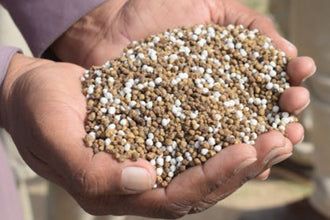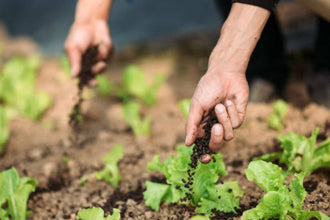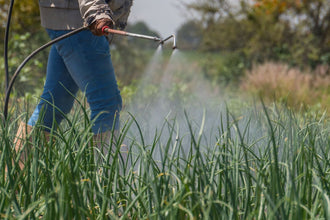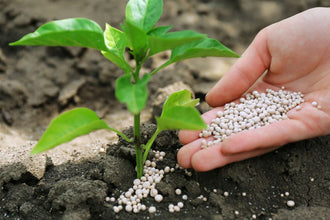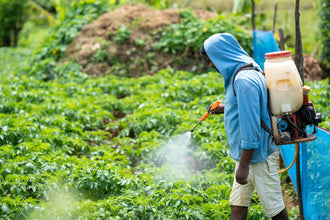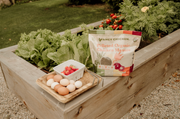
Good fertilizer application can make your garden flourish while poor timing leaves plants struggling. Too many gardeners just dump fertilizer around their plants without understanding how timing, rates, and methods work together. This usually leads to wasted money and disappointing results.
Getting fertilizer application right means knowing your soil, understanding plant growth patterns, and matching nutrients to what your plants actually need. You can't just follow the package directions and hope for the best. Your garden has unique conditions that affect how fertilizer works.
Understanding Fertilizer Application Basics
Smart fertilizer application starts with knowing what your plants need at different times. A tomato seedling needs gentle feeding while a mature plant loaded with fruit demands much more nutrition. Plants don't need the same amount of food all season long.
Soil temperature plays a huge role in how fertilizer application works. Cold soil slows down the tiny organisms that help break down organic fertilizers. Your plants can't use those nutrients until the soil warms up enough. Synthetic fertilizers dissolve faster but they can shock plants if you're not careful.
Weather affects every fertilizer application you make. Rain helps dissolve granular fertilizers and carries nutrients down to the roots. But heavy storms can wash nutrients away before plants grab them. During dry spells, you need to water after applying fertilizer or nothing happens.
Why Soil Testing Matters
Testing your soil before any fertilizer application saves you from making expensive mistakes. Basic test kits tell you pH and major nutrients. Professional tests give you the whole picture including trace elements and organic matter levels.
Your soil's pH controls whether plants can actually use the fertilizer you apply. Acidic soil locks up phosphorus while alkaline soil prevents iron absorption. Most garden plants do best when pH stays between 6.0 and 7.0.
The amount of organic matter in your soil changes everything about fertilizer application. Rich soil holds nutrients longer and releases them slowly. Sandy soil drains fast and needs lighter, more frequent feeding. Clay soil holds nutrients well but water might not penetrate properly.
Reading Plant Signs for Better Timing
Your plants tell you when they need fertilizer if you know what to look for. Pale yellow leaves usually mean nitrogen shortage, especially on older leaves first. Purple edges or weak roots often point to phosphorus problems.
Weak stems and plants that get sick easily might need potassium. But these same symptoms can come from watering issues or pest problems. Always consider other factors before changing your fertilizer application schedule.
Plant growth patterns give you timing clues too. Spring growth needs nitrogen while flowers and fruits need phosphorus and potassium. Root vegetables want phosphorus early and potassium when the roots start forming.
Different Methods for Fertilizer Application
The way you apply fertilizer matters just as much as what you use and when you use it. Each method works better for different situations and plant types.

Broadcasting Works for Large Areas
Broadcasting spreads fertilizer evenly over big areas like vegetable beds or lawns. This fertilizer application method gives consistent nutrition across the whole growing space. It works great with granular fertilizers that dissolve slowly.
You need even coverage to prevent fertilizer burn and make sure all plants get fed equally. Use a spreader for large areas or practice hand spreading for smaller gardens. Here's how to broadcast effectively:
-
Apply to slightly damp soil when possible
-
Water lightly after application to start dissolving
-
Time applications for active growth periods
-
Avoid windy days that scatter fertilizer unevenly
Side-Dressing Targets Individual Plants
Side-dressing puts fertilizer right where plants can use it without waste. You make shallow furrows about 4-6 inches from plant stems and sprinkle fertilizer along the furrow. Then cover lightly with soil and water well.
This targeted fertilizer application method reduces nutrient loss and keeps weeds from stealing plant food. You can adjust nutrition for different plants based on what they actually need. Side-dressing works especially well for:
-
Heavy feeders like tomatoes and corn
-
Plants that produce all season long
-
When you want to avoid disturbing roots
-
Giving extra nutrition during peak growth
Apply side-dress fertilizer when plants are growing actively but not stressed from heat or drought. Early morning works best because nutrients dissolve and move into soil before the hot sun hits.
Liquid Applications Give Quick Results
Liquid fertilizers provide nutrition that plants can use right away. You have precise control over how much you apply and where it goes. Always dilute concentrates according to directions because too much strength burns roots and leaves.
Drip irrigation systems work perfectly for regular liquid fertilizer application. You get consistent feeding with minimal water waste. Just check filters often because organic liquids can clog emitters.
For smaller gardens, watering cans work fine for liquid fertilizer application. Apply in early morning or late afternoon to reduce evaporation and prevent leaf burn.
Getting Your Fertilizer Application Timing Right
Timing makes or breaks your fertilizer application success. Plants need different nutrition at different times of year, and you can't fight the seasons.
Spring Applications Fuel New Growth
Start spring fertilizer application when soil temperature hits 50-60°F and stays there. Cold soil prevents nutrient uptake and can cause buildup that hurts plants later. Check soil temperature at 4-inch depth with a thermometer.
Cool weather crops like lettuce and peas can handle early spring fertilizer application. These plants grow in cooler weather and need nutrients available when growth starts. Wait for warm weather plants until soil heats up properly.
Organic fertilizers need extra time to break down before plants can use them. Apply compost and organic fertilizers 2-3 weeks before planting. Synthetic fertilizers can go on closer to planting time.
Summer Feeding Keeps Plants Going
Summer fertilizer application maintains plant health during the busiest growing time. Light, frequent applications work better than one big dose. Plants use nutrients quickly in hot weather but they also lose them faster through increased watering.
Container plants need more frequent fertilizer application than garden beds. Nutrients wash out of pots faster, especially during hot weather with daily watering. Weekly liquid feeding often beats monthly granular applications for containers.
Vegetable gardens producing continuous harvests benefit from regular fertilizer application all season long. Tomatoes, peppers, and beans produce for months and steadily use up soil nutrients.
Fall Prep for Next Year
Fall fertilizer application prepares plants for winter and supports root development. Avoid high-nitrogen fertilizers late in the season because they promote soft growth that frost kills easily. Focus on phosphorus and potassium to toughen plants for winter.
Most perennials benefit from fall feeding that helps them store energy for spring growth. Trees and shrubs use fall nutrients to develop stronger root systems over winter.
Calculating Fertilizer Application Rates
Getting fertilizer application rates right prevents waste and plant damage while making sure plants get enough food. Package labels give general rates but your specific conditions might need adjustments.
Understanding fertilizer numbers helps you calculate actual nutrient amounts. A 10-10-10 fertilizer contains 10% each of nitrogen, phosphorus, and potassium by weight. A 50-pound bag gives you 5 pounds of each nutrient.
Most vegetables need 1-2 pounds of actual nitrogen per 1,000 square feet per growing season. Split this amount among several applications instead of dumping it all at once. Heavy feeders like corn need the higher rate while lettuce needs less.
Converting Rates for Your Garden Size
Package rates often list pounds per acre, which you need to convert for home gardens. One acre equals 43,560 square feet. A typical city lot runs about 6,000-8,000 square feet, roughly one-sixth to one-fifth of an acre.
Calculate your garden area by multiplying length times width. Divide the package rate by the right fraction to figure out how much fertilizer your space needs. Always round down rather than up to prevent over-application.
Keep records of your fertilizer application rates and timing. This information helps you improve your program over time and identify what works best for your conditions.
Organic vs Synthetic Rate Differences
Organic fertilizers usually require higher application rates because they contain lower nutrient concentrations. But they release nutrients slowly and last longer in soil. One organic fertilizer application might feed plants for months.
Synthetic fertilizers provide quick nutrition at lower application rates. However, nutrients wash out faster and may need more frequent applications. The total seasonal amount might be similar but timing differs a lot.
Many gardeners use both approaches, applying organic fertilizer for long-term soil health and synthetic supplements for quick nutrition boosts when needed.
Fancy Chicken Organic Pelletized Chicken Manure Application Guide
Fancy Chicken organic pelletized chicken manure requires different application rates than synthetic fertilizers due to its concentrated organic nature. The pelletized form delivers more nutrition per pound than raw manure while being much easier to measure and apply evenly across your garden.
For general garden beds, apply 2-4 pounds of Fancy Chicken pellets per 100 square feet during spring preparation. Heavy feeders like tomatoes, peppers, and corn benefit from the higher rate, while established perennials and less demanding crops thrive with lighter applications. The organic composition means you can be generous without fear of burning plants.
Recommended application rates:
-
New garden beds: 4-5 pounds per 100 square feet
-
Established vegetable gardens: 3-4 pounds per 100 square feet
-
Flower beds and perennials: 2-3 pounds per 100 square feet
-
Container plants: 1-2 tablespoons per gallon of soil
-
Tree and shrub base: 1/4 cup per foot of plant height
-
Lawn overseeding: 10-15 pounds per 1,000 square feet
Optimal Timing for Fancy Chicken Pellet Applications
Spring application timing depends on soil temperature rather than calendar dates. Apply Fancy Chicken pellets when soil temperature reaches 45-50°F and stays consistent. This allows the organic matter to begin decomposing before plants enter their active growth phase.
The pelletized form breaks down faster than raw organic materials, making it more responsive to seasonal changes. Early spring applications provide gentle feeding that won't shock tender new growth, while the steady nutrient release supports plants through their most demanding growth periods.
Seasonal application schedule:
-
Early spring: Primary application 3-4 weeks before planting
-
Late spring: Side-dress heavy feeders at flowering stage
-
Mid-summer: Light boost for continuous producers like tomatoes
-
Early fall: Final feeding 6-8 weeks before first frost
-
Container gardens: Monthly light applications during growing season
Application Methods That Maximize Results
Broadcasting Fancy Chicken pellets works well for preparing large garden beds before planting. The uniform pellet size ensures even distribution whether you're using a spreader or applying by hand. Work the pellets into the top 4-6 inches of soil to place nutrients where developing roots can find them easily.
Side-dressing established plants with Fancy Chicken pellets provides targeted nutrition without disturbing root systems. Create shallow furrows 4-6 inches from plant stems, sprinkle pellets along the furrow, and cover lightly with soil. This method concentrates nutrients where plants need them most while reducing waste.
Best application practices:
-
Apply to slightly moist soil for faster activation
-
Water thoroughly after application to begin decomposition
-
Avoid applying during extreme heat or drought stress
-
Work pellets into soil rather than leaving on surface
-
Apply early morning to prevent pellet blow-away
-
Store unused pellets in dry location for maximum shelf life
Adjusting Rates for Different Growing Conditions
Sandy soils drain quickly and may need slightly higher application rates of Fancy Chicken pellets to compensate for faster nutrient movement. The organic matter in the pellets helps improve water retention while providing steady nutrition.
Clay soils hold nutrients longer, allowing you to use standard or even reduced rates while still achieving excellent results. The pellets help improve soil structure as they decompose, creating better drainage and root penetration over time.
Container gardens require more frequent applications since nutrients wash out with regular watering. Use smaller amounts more often rather than heavy applications that might overwhelm the limited soil volume. Monthly feeding during the growing season typically provides optimal nutrition for potted plants.
Monitor plant response throughout the season to fine-tune your application program. Consistent green color and steady growth indicate proper nutrition levels, while yellowing or slow growth may signal the need for supplemental feeding or adjusted timing for future applications.
Start Feeding Your Garden the Right Way
Smart fertilizer application turns struggling gardens into productive growing spaces. Your plants will show stronger growth, better disease resistance, and bigger harvests when you feed them properly at the right times.
Begin by testing your soil to understand what nutrients you're working with. Then create a fertilizer application schedule that matches your plants and local growing conditions. Keep track of what works and adjust as you learn more about your garden's needs. Quality fertilizer applied at the right time and rate will reward you with the thriving garden you've always wanted.




